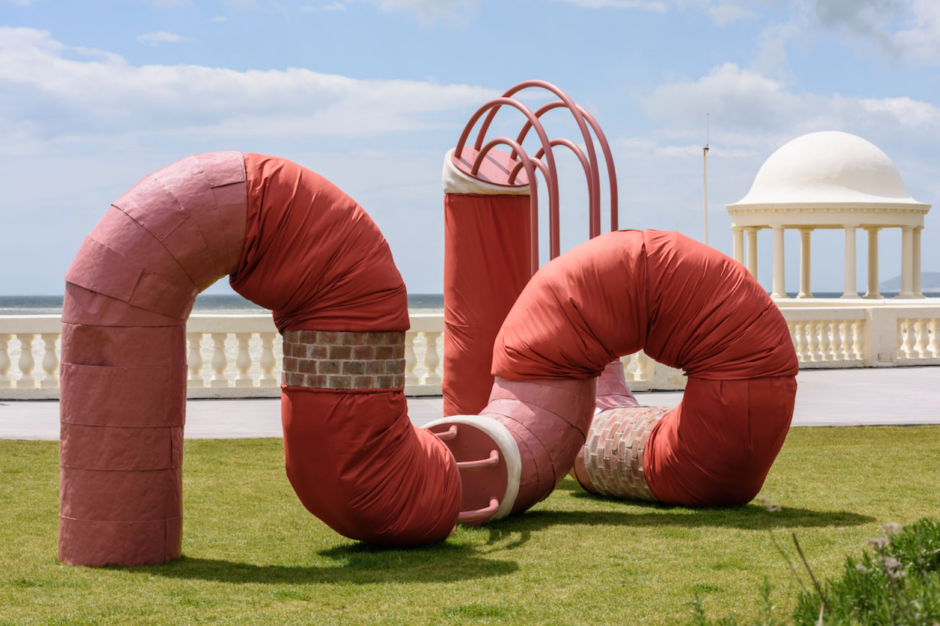England’s Creative Coast Opens with all Partners. Combining seven Waterfronts art commissions by internationally acclaimed artists with the world’s first art GeoTour, England’s Creative Coast is a new cultural experience connecting art with landscape, local stories with global perspectives and linking seven outstanding arts organisations—Cement Fields, Creative Folkestone, De La Warr Pavilion, Hastings Contemporary, Metal, Towner Eastbourne, and lead partner Turner Contemporary.
“At its heart England’s Creative Coast is about connections — connecting people to places, artists with the coast, creative organisations with landscape and with each other, and about connecting visitors to the history of the people and places on the coast. Ultimately it is about using the power of partnership to forge human connections: allowing people to explore a place, an artwork, and its community, together — something that is needed now more than ever” — Sarah Dance, Project Director of England’s Creative Coast
WATERFRONTS
“Waterfronts offers audiences the chance to consider the natural, historical and political aspects of England’s porous coastline through the eyes of seven artists from five countries. Each spent time exploring the layered histories and complexities of their partner’s specific locations, bringing to these their own unique working methods and personal perspectives on this liminal space between land and water.”— Tamsin Dillon, Waterfronts Curator
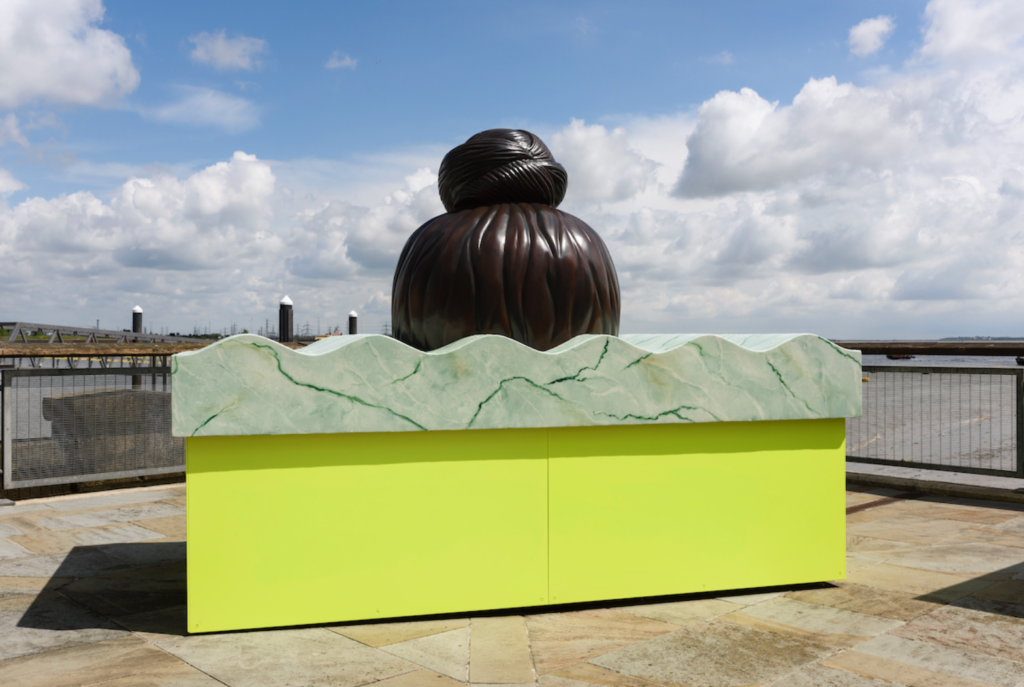
Cement Fields
Jasleen Kaur: ‘The first thing I did was to kiss the ground’
Royal Pier, Gravesend, Kent, DA12 2BD
‘The first thing I did was to kiss the ground’ by London-based artist Jasleen Kaur is a work in two parts: a sculpture and a sound-piece made in collaboration with local Saheli Women. Sited right on the edge of the water at the mouth of the river Thames, its jumping off point is Gravesend’s rich and complex history of migration.
“It’s a really particular landscape … you feel the weight of its history. There is a small passenger ferry taking you across to Tilbury Dock, you can see the old Cruise Terminal building and the flag-post compete with Union Jack flag. So there are all these reminders, in amongst the industrial functioning landscape, of another time and place: when migration was welcomed and bound up with rehabilitating a post war Britain.”
— Jasleen Kaur
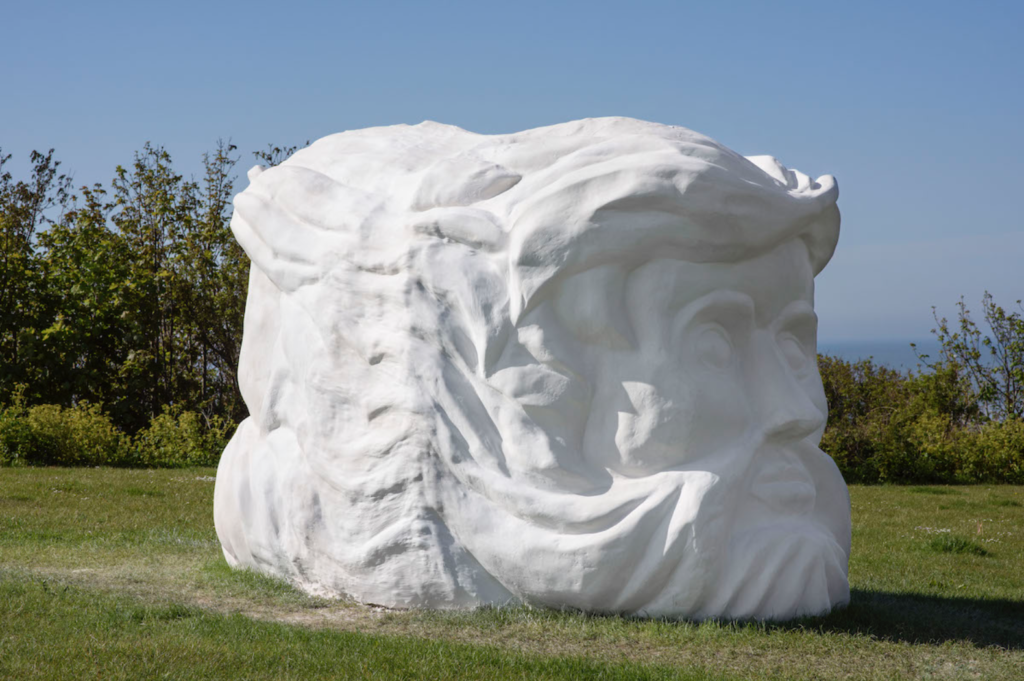
Creative Folkestone
Pilar Quinteros: ‘Janus Fortress: Folkestone’
Wear Bay Rd Green, Folkestone, Kent, CT19 6PL
‘Janus Fortress: Folkestone’ by Chilean artist Pilar Quinteros is a multifaceted work that will evolve over time. The god of beginnings, gates, transitions, time, duality and endings in ancient Roman religion and myth, Janus is usually depicted with two faces. Quinteros’s sculpture likewise presents two faces, one looking inland and the other gazing at the sea, symbolising the duality of borders — of looking outwards while protecting inwards.
“For much of human history it was believed that we lived in a world of binary nature, of opposites. Working for Waterfronts and the specific location of Folkestone makes me think of that region of the country and its history being an important border, as a place of simultaneous entries and exits. It is a precise place to think about the supposedly opposites and what can be in the middle. Art, I think, opens that possibility.”
— Pilar Quinteros
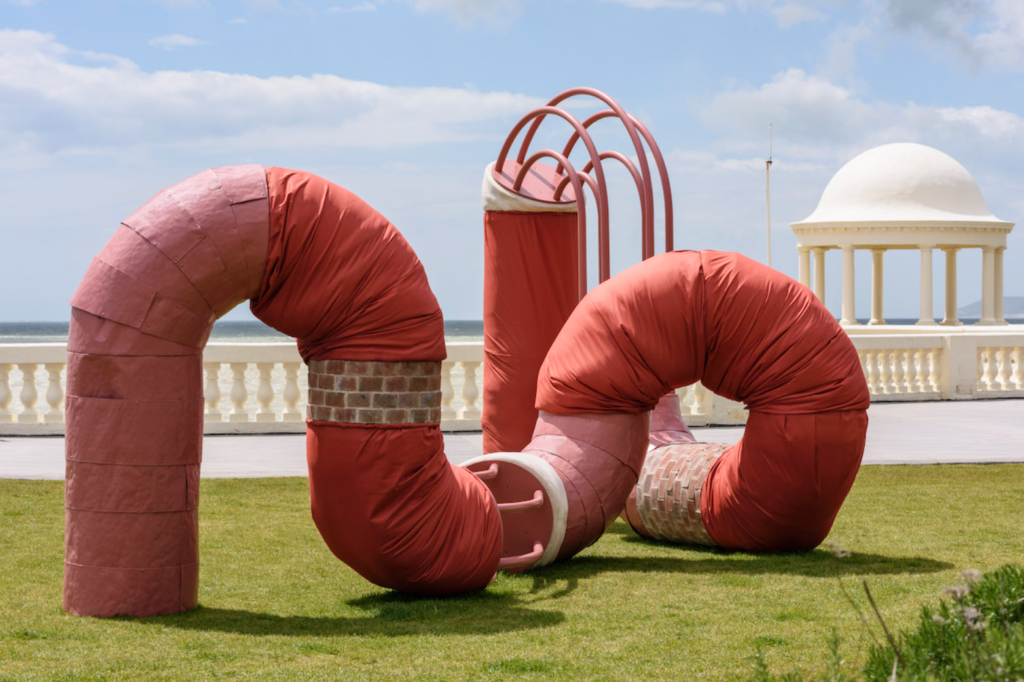
De La Warr Pavilion
Holly Hendry: ‘Invertebrate’
Bexhill-on-Sea, East Sussex, TN40 1DP
‘Invertebrate’ by British artist Holly Henry is a giant form that worms its way around the outside of De La Warr Pavilion from the seafront lawn to the first floor balcony and the roof, constructed out of materials that resonate with its location; while inside an accompanying exhibition ‘Indifferent Deep’ reimagines the iconic modernist building as a porous body that has been partially munched.
“Making an artwork for Waterfronts, for me, is a consideration of edges. This deals with ideas of above and below, inside and outside, on the land, in the sea or under the ground. Edges seem to be definitive, a beginning or an end, a perimeter of sorts, and a line that highlights contested notions of ownership and free movement.”
— Holly Hendry
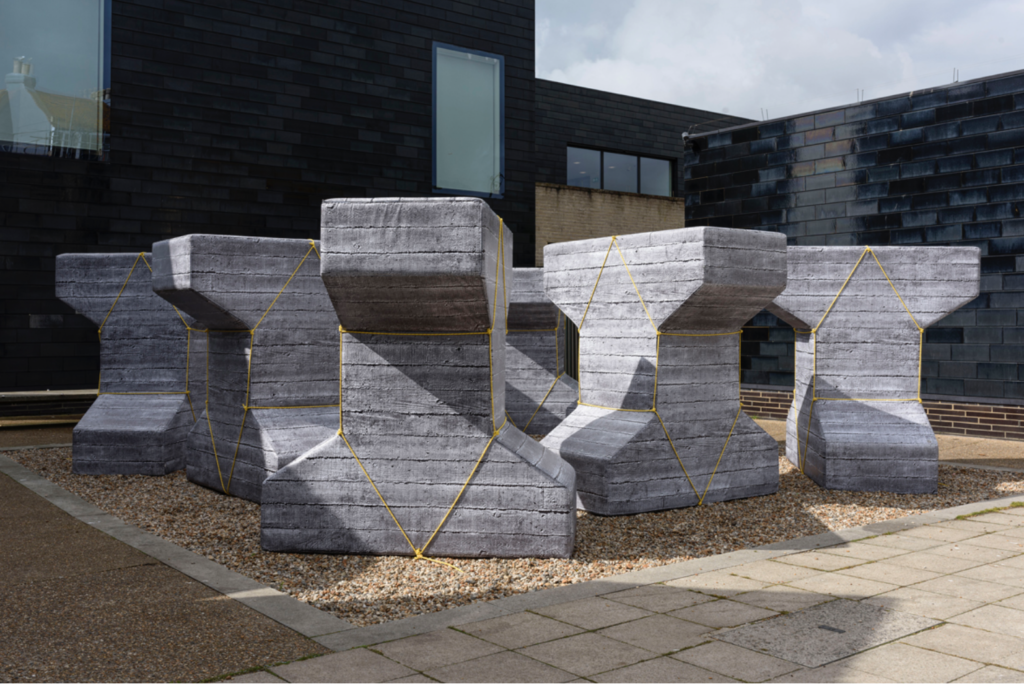
Hastings Contemporary
Andreas Angelidakis: ‘Seawall’
Rock-a-Nore Road, Hastings, East Sussex, TN34 3DW
‘Seawall’ by Greek artist Andreas Angelidakis occupies the courtyard space outside Hastings Contemporary. Resembling the concrete accropode structures designed to resist the action of waves on coastal locations, up close the blocks reveal themselves to be reconfigurable soft sculptures. Softening what at first appears hard, the artwork queers the idea of the seawall, playing with expectations and prompting questions while swerving any rigid definitions.
“We are living in a moment of unsure transitions, from what we used to know the world to be, towards an unpredictable future. This uncertainty manifests itself on many scales. We are migrants and we don’t know if we will reach our destination, we are consumers inside a failed economic system, we are workers trapped in political systems that continue to look out for the well-being of the powerful. Finally, we are humans whose way of life is destroying our home, as well as the home to every other living creature. Standing on a beach, like Hastings, is the perfect spot to look out to what the future brings, to look out to the horizon.”
— Andreas Angelidakis
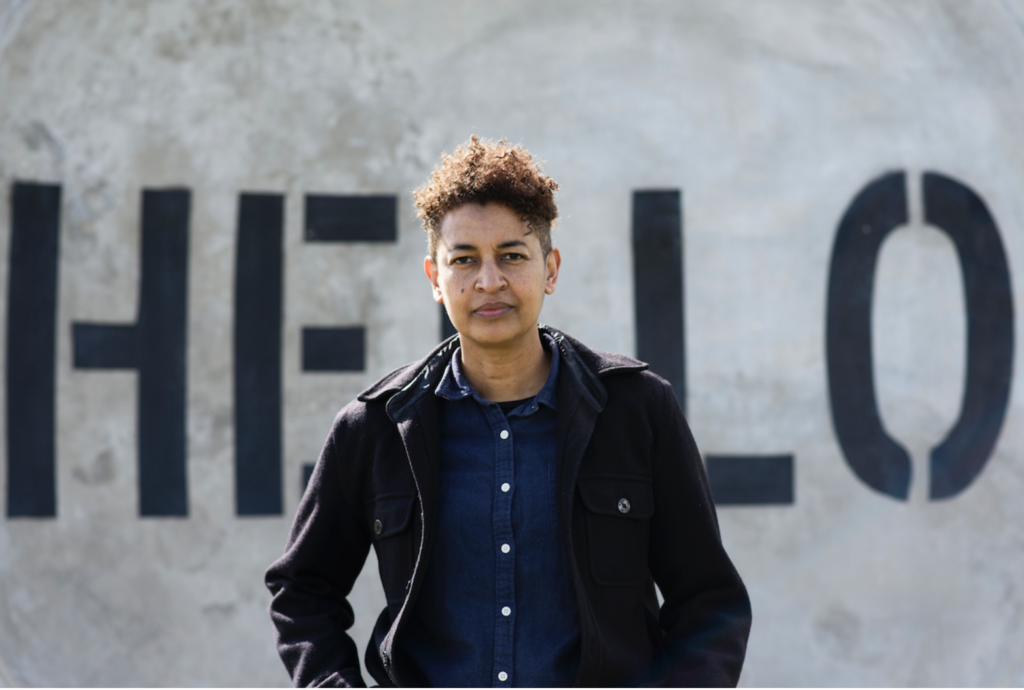
Metal
Katrina Palmer: ‘HELLO’ and ‘RETREAT’
East Beach, Shoeburyness, Southend-on-Sea, Essex, SS3 9AD
British artist Katrina Palmer’s Waterfronts commission is a work in two halves: ‘HELLO’, a large concrete form based on a sound mirror, subverting the pre-radar enemy aircraft early-warning structures that dotted the British coastline into a message of welcome; and ‘RETREAT’, a meditation on identity — or non-identity and how to move towards the future that shadows Palmer’s journeying by foot along the South End-Shoeburyness shoreline.
“Exploring the coast at Southend-on-Sea and Shoeburyness is an experience of the precarious edge of England. I’ve been given this opportunity at a moment of profound uncertainty about our capacity to find a way forward, where the possibility of imaginatively envisaging the future, when our connections to the continent and to the environment and even a concept of common humanity seem distanced ideals.”
— Katrina Palmer
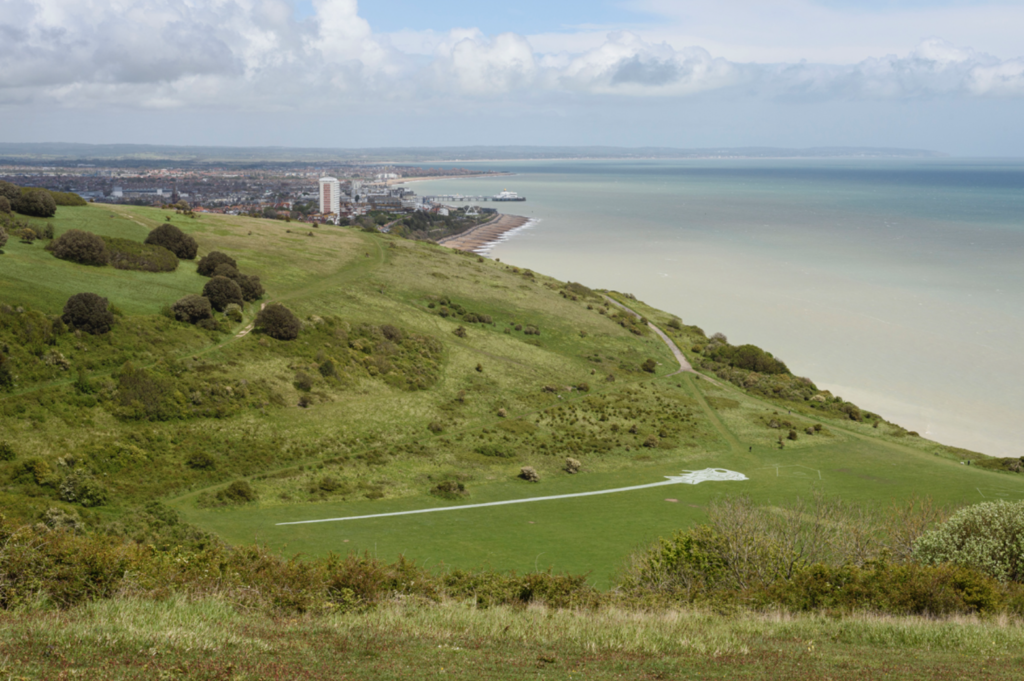
Towner Eastbourne
Mariana Castillo Deball: ‘Walking through the town I followed a pattern on the pavement that became the magnified silhouette of a woman’s profile’
Eastbourne, East Sussex
‘Walking through the town I followed a pattern on the pavement that became the magnified silhouette of a woman’s profile’ by Mexican artist Mariana Castillo Deball takes as its inspiration a nearby archaeological find: the body of a young ‘Frankish woman’ excavated at St Anne’s, Eastbourne, in the late ’90s along with a number of funerary objects dating back to the Iron and Bronze ages. Consisting of a 160m long chalk drawing on the Beach Head Down, a stencilled rope demarcating a route through the town and sculptural objects embedded in the pavement, it can be experienced as, the artist says, “an image, a walking path, or a narrative.”
“It’s an opportunity to do something that appears monumental but at the same time is very simple. It’s a drawing on a scale that I never imagined I’d be able to do, but which at the same time is not invasive and is made out of materials that will fade back into the environment.”
— Mariana Castillo Deball
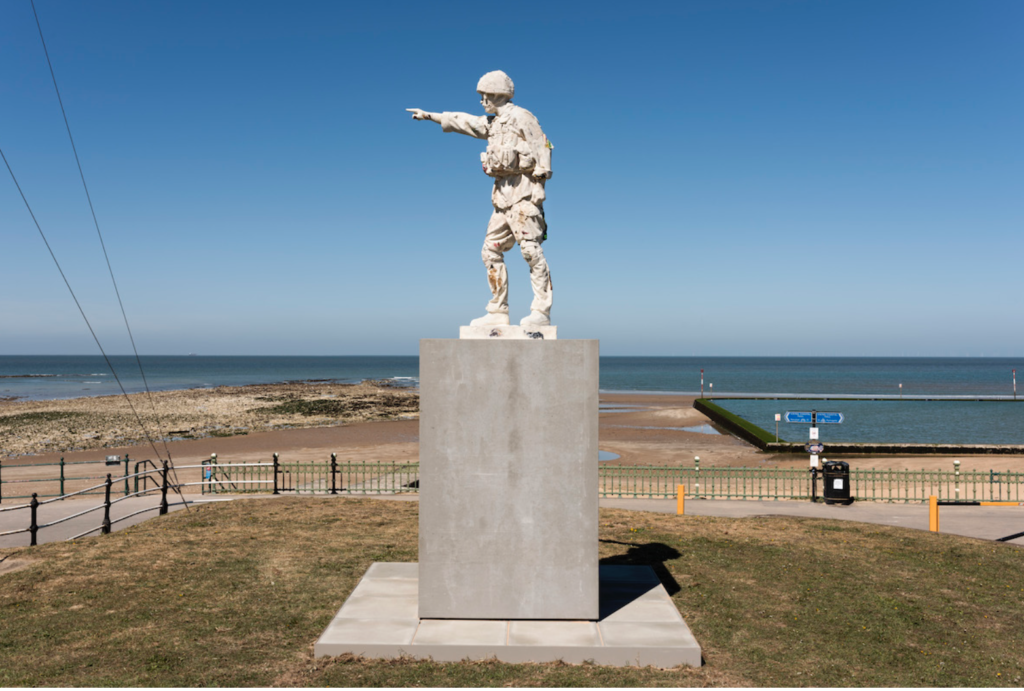
Turner Contemporary
Michael Rakowitz: ‘April is the cruellest month’
Royal Crescent Promenade, Margate, Kent, TN34 3DW
‘April is the cruellest month’ by American-Iraqi artist Michael Rakowitz introduces a new life-sized statue on the Margate seafront, in dialogue with the Surfboat memorial figure of a lifeguard who gazes out to sea to rescue people and overlooked by the shelter where T.S. Eliot wrote part of ‘The Waste Land’. An anti-war memorial, it is a sculpture of Veteran for Peace Daniel Taylor made of an aggregate that includes earth from Basra and chalk from Margate embedded with fossil-like votive offerings including Taylor’s own medal.
“There are many things that interest and excite me about the prospect of making a site-specific work in Margate. The history of poets and rescuers looking out at the sea for inspiration and life has informed my project, as has the fossil bearing rock of the coast, which reminds me that stone is an archive. But I am also led by urgency, of understanding what it means to be at the edge of a place, where hospitality and hostility mix.”
— Michael Rakowitz
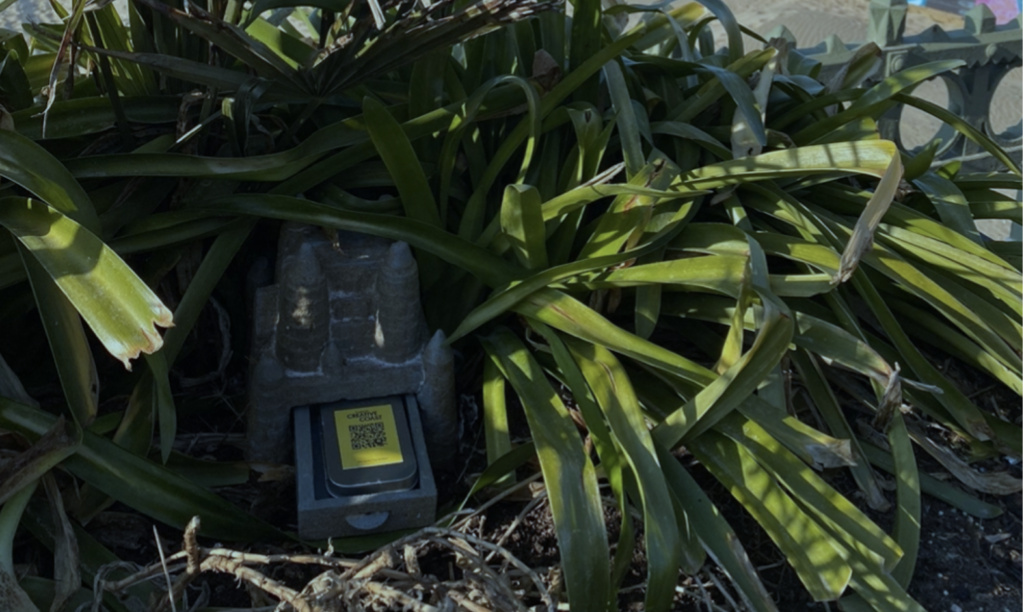
THE WORLD’S FIRST ART GEOTOUR
To participate download the GeoCaching app via the App store, GeoTour code: GT4A5
Using geocaching, the GPS-enabled digital treasure hunt technology, communities from each of the seven locations were invited to share their personal stories of what it’s like to live in that particular coastal place, respond to the new artwork in their town and give visitors a new way to interact with the landscape. Participants have been guided by artists and include school children, scout groups, communities such as the Kent Saheli Group and charities such as the Hastings-based Refugee Buddy Project and Rough Sleeper Initiative.
Further information can be found on England’s Creative Coast’s website.
England’s Creative Coast is led by Turner Contemporary and Visit Kent. It is principally funded by Arts Council England’s Cultural Destinations programme and Visit England / Visit Britain through the Discover England Fund.

